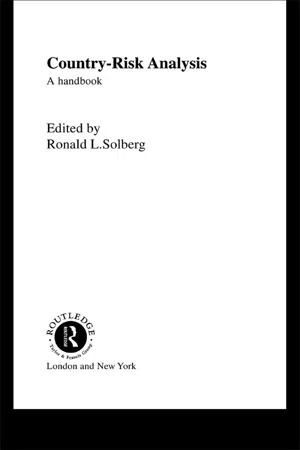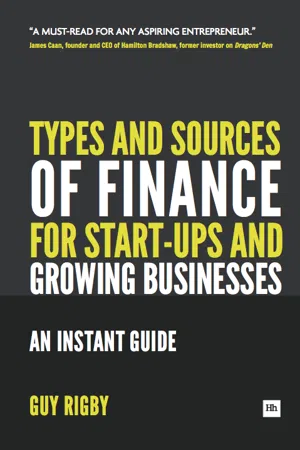External Financing
External financing refers to the funds a business raises from sources outside the company, such as loans, issuing bonds, or selling equity. This type of financing allows businesses to raise capital to support growth, expansion, or to meet financial obligations. External financing can provide businesses with additional resources to invest in new projects or cover operational costs.
7 Key excerpts on "External Financing"
- eBook - ePub
Creating a Thriving Business
How to Build an Immensely Profitable Business in 7 Easy Steps
- George Horrigan(Author)
- 2012(Publication Date)
- Morgan James Publishing(Publisher)
...This is because the financing of an asset is relatively straightforward and is not a strategic action; however, anything involving the funding of your business operation is strategic. Complete exercise 8-6 in workbook SOURCES OF FINANCING Where can you obtain funding for your business? There are a large number of options but they basically fall into two categories: Owner financing (you fund the business yourself) and outside financing (others fund your business). Here is a checklist for each: Owner Financing • Personal funds that you as an owner put into your business —This may come from your checking account, savings account, or investments. • Refinancing your house —Refinancing your residence for an amount greater than its current mortgage and placing the additional amount into your business. • Home equity loans —Taking out a home equity loan or a home equity line of credit on real estate that you own. • Second mortgage —Borrowing on your personal residence by taking out a second mortgage. • Loans on other assets —Loans using any asset that you own personally (e.g., second home, automobile, boat, investments) as collateral...
- eBook - ePub
- Richard Roberts(Author)
- 2015(Publication Date)
- Routledge(Publisher)
...In this chapter, using data from the UK, the products for both the day-to-day and the capacity-building finance needs of small firms are identified. First, this is done by looking at the aggregate profile of financing of small firms in the UK. Second, the sources of external finance selected from the UK analysis are reviewed against similar data for key international markets. External versus internal funding Prior to looking at the external financial products used by small firms, it is also necessary to consider in more detail the circumstances in which they are needed. It could be argued that it would make sense if businesses never needed to use external finance at all either for cash-flow or expansion purposes; indeed, for many firms, this is their goal and operating practice and in such circumstances the use of any form of external finance reduces the immediate financial returns to the business owners to some degree. Many business owners look to achieve this position as well as it provides the firm with a degree of independence and security. A large number of firms, as illustrated later in this chapter, report they do not use any external funding. These firms are fully funded from internal sources, mainly for cash-flow purposes without any plans for expansion or growth. While external commentators may well argue that the desire for financial independence may only be achieved at the expense of a firm reaching its full potential, it is very understandable, given the wide range of motivations people have for going into business in the first place, why the objective of self-sufficiency in cash-flow funding is attractive to many. However, this, in turn, creates differing views on the desirability of external finance when needed...
- eBook - ePub
The Professional Practice of Landscape Architecture
A Complete Guide to Starting and Running Your Own Firm
- Walter Rogers(Author)
- 2010(Publication Date)
- Wiley(Publisher)
...If the firm needs the funds for operating materials, the firm may have a readily available source of funds by relying on trade credit. Determining what form of financing will be used depends upon the equity, or retained earnings, in the firm, the financial health of the firm and its owners, and the amount of debt already incurred by the firm. Short-term money needs are usually funded by the profits and equity in the firm. Immediate short-term needs also can be funded by an operating line of credit or a revolving line of credit for which creditors usually require payment in the near future. Long-term funds used for equipment and real estate funding are almost always provided from loan capital. Start-up financing decisions are influenced by the form of the business. Sole proprietors and partnerships may be financed initially by personal contributions of funds, loans, venture capital from a silent partner, or bringing in another owner or partner. Corporations have the legal ability to raise funds by selling stock either to members of the firm or to outside investors. Large corporations that have the possibility of revenue growth may consider selling stock to the general public to raise funds. Investors buy the stock because they believe the firm has the potential to provide them with a good return on their investment. There are a number of large multidisciplinary firms listed on stock exchanges such as the New York Stock Exchange, including the giant firm AECOM. A landscape architect working for a publicly traded firm like AECOM will know the stock value on a daily basis by going to the stock price listings in the stock market indexes published in newspapers and online. Once the firm has an established operating and credit track record, the sources of financing will vary. Private financing from friends or family is one of the first sources to explore when the need for capital arises. Financial institutions, banks, private investors, and governments are other sources...
- eBook - ePub
Financial Accounting (RLE Accounting)
An Introduction
- John Blake(Author)
- 2013(Publication Date)
- Routledge(Publisher)
...8 SOURCES OF FINANCE Objectives This chapter has two broad objectives: 1 To give an introduction to the various sources of finance shown in a business balance sheet, explaining their significance and how they are accounted for. 2 To introduce the major factors taken into account in deciding how to raise finance for the establishment, running, and expansion, of a business. Specifically we consider 1 The ways in which new shares can be issued. 2 Retained profits as a source of finance. 3 Forms of long-term borrowing. 4 Types of short-term borrowing. 5 The nature of the tax liabilities shown in the balance sheet. 6 Sources of finance which do not appear in the balance sheet. 7 The effect of the financial structure on fluctuations in profit (gearing). 8 The relationship between the trading structure and the financial structure. 9 The factors taken into account in choosing between sources of finance. Raising funds from share issues One of the sources from which a new company will derive funds will be from the issue of shares in the business. If additional finance is required during a company's life an issue of new shares is one way of raising finance that might be considered. In this respect a private company, which is not permitted to issue any form of security to the public, is at a severe disadvantage compared to a public company. A public company will normally only be able to benefit from the legal permission to issue securities to the public if it is listed on the Stock Exchange. To become a listed company requires approval from the Council of the Stock Exchange, which is only granted if a range of regulations are complied with...
- eBook - ePub
Country Risk Analysis
A Handbook
- Ronald L. Solberg(Author)
- 2002(Publication Date)
- Routledge(Publisher)
...Net transactions involving monetary gold and official foreign-exchange reserves are also included as part of the debtor country’;s External Financing. The demand for External Financing is a function of a wide range of factors that determines a country’;s ability to generate and spend foreign exchange or hard-currency earnings. Natural physical and human endowments and the structure and development of the manufacturing and agricultural sectors are examples of a country’;s basic economic characteristics that influence external trade and service flows. But estimating the demand for External Financing integrates these characteristics with appraisals of monetary, fiscal and exchange-rate policies. The external payments profile of a debtor country is obtained by matching the supply and demand for External Financing. This approach does not allow for gaps in financing, and a mis-match between ex ante demand and supply must be financed by additional funds from external creditors, a drawdown of official international reserves, or eliminated by policy measures taken by a debtor country designed to conserve the use of foreign exchange. The failure of any one or some combination of all of these to occur means that the country will experience a shortage of foreign exchange and the financing gap will be closed ex post by an interruption in debt-service payments. External debt Constructing the capital account to document creditor flows provides a direct link between External Financing and debt. Since the terms and conditions of external loans vary considerably among the external creditors, it is essential to document the level and change in external debt owed to each creditor properly to forecast future debt-service payments...
- eBook - ePub
Types and Sources of Finance for Start-up and Growing Businesses
An Instant Guide
- Guy Rigby(Author)
- 2011(Publication Date)
- Harriman House(Publisher)
...In addition, businesses that are highly geared (i.e. those with large borrowings in relation to their equity) are more likely to face difficulties in the event of a slowdown in demand or an unexpected loss. As always, it’s a question of balance. The equity, which is the fixed capital of the business, needs to be sufficient to support the business after all other factors have been taken into account, with sufficient headroom to weather unexpected storms, should these occur. One well-established principle is that a business should not borrow short to invest long – for example, the use of an overdraft facility that is repayable on demand to finance property or equipment that will be used by a business over many years. If the overdraft is called in, it may be difficult to realise the assets or secure alternative finance, potentially causing the business to commit the ultimate sin – running out of cash. “Trying to fund growth in the long term using short-term finance is not going to work,” says David Molian of Cranfield School of Management. “Historically too many businesses have relied on short-term debt funding, principally overdraft arrangements from their bank, which are liable to be vulnerable in recessionary periods.” There are four main financing options: equity, debt, sales and asset financing. All of these, bar equity, involve the business taking on borrowings. In practice, most businesses will use a number of different sources over time. Financing options TYPE: Debt or equity SOURCE: Friends and family Many businesses start with funding from friends or family, aka the ‘Bank of Friends’ or the ‘Bank of Mum & Dad’. In practice, this will often be the cheapest and easiest route to gaining early stage funding, with loans often being made on a low interest or even an interest-free basis...
- eBook - ePub
Economics
A Foundation Course for the Built Environment
- J.E. Manser(Author)
- 2003(Publication Date)
- Routledge(Publisher)
...The commitment to large sums in interest payments would add another risk in an already high-risk business. SOURCES OF LONG-TERM FUNDING Permanent capital is initially provided by the owners of a business, its shareholders if it is a company. Once established, the most important source of finance is internal—the firm’s own profits. Some profit will be distributed as dividends, the rest retained for use in the business to improve its earning potential. Shareholders benefit from this investment as the rising value of the company is reflected in its share prices. How much profit is retained and how much distributed is a matter of policy. Some companies prefer to keep dividends stable, so as to preserve shareholders’ income. When profits are low this entails using cash reserves, something which cannot be repeated too often or the business will suffer. Others, especially family firms, aim to plough back most of the profits. Debentures, which can be traded in the same way as shares, are bonds (i.e. debt) issued to the public. They carry a fixed rate of interest instead of paying dividends. Unlike dividends, which are payable at the board’s discretion, interest payments must be made whether the business is trading profitably or not. They are not widely used in the private sector. Government finance is available in many forms, including tax relief, loans and grants. Two bodies were set up specifically to aid investment in industry, the National Enterprise Board (NEB), mostly concerned with larger companies, and the Industrial and Commercial Finance Corporation (ICFC) to assist medium and smaller firms. ICFC was later reorganized as a part of the Investors in Industry (3i) group and funded by the banks. A number of other venture capital funds have been set up, but despite this the ‘equity gap’ persists...






